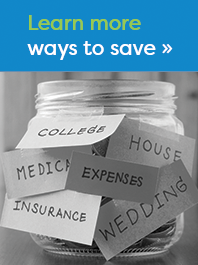Preparing for Life's Surprises

Have you ever heard the saying, “Don’t put all your eggs in one basket”? Most of us understand it to be a warning of the risks when we encounter an unexpected bump in the road. It can apply to customers who are struggling with putting money into savings, when they are concerned they should be paying down debt.
Rising costs and interests rates have inspired Canadians to cite debt repayment as their top priority in 2019. While debt repayment is always a priority we support, doing so without a savings plan can be downright frustrating when life decides to say “Surprise!” with car repairs, vet bills or an unexpected job loss. We encourage all members to establish an emergency fund for just such a reason. Here are the top three questions customers often asked about emergency funds:
Revised Jul. 4, 2021
Rising costs and interests rates have inspired Canadians to cite debt repayment as their top priority in 2019. While debt repayment is always a priority we support, doing so without a savings plan can be downright frustrating when life decides to say “Surprise!” with car repairs, vet bills or an unexpected job loss. We encourage all members to establish an emergency fund for just such a reason. Here are the top three questions customers often asked about emergency funds:
- How much do I need to save? Many experts encourage 3-6 months of living expenses, especially in the event of a job loss. Others suggest a minimum of $1,000 which can cover basic, unbudgeted items. A good rule of thumb is the more you own, the more you need to save. For example, someone who owns a house, cottage, truck and three dogs would be advised to save more than a student who lives at home and owns a used car. The good news? Once you reach your savings goal, you can redirect your regular contributions to other priorities.
- What type of account should I use? Having more than one savings account is a great strategy, but it will require you to spread your savings dollars across multiple accounts. We recommend at least two, keeping fun funds (i.e. vacation) separate from emergency funds. A Tax-Free Savings Account (TFSA) is a great option for your emergency fund because you can earn interest on your savings, while still accessing the funds if you need them. The biggest benefits of a TFSA? They’re not accessible by using your debit card, and they’re easy to forget about if you “set it and forget it”. More on that below.
- How can I get started? If you’re ready to set up an emergency fund, the first step is to review your budget with a Financial Advisor. Together, you’ll determine how much you can realistically put away each month. From there, you can “set it and forget it” with an Automatic Funds Transfer that will move the amount of money you choose into a savings account on a schedule that works for you.
Revised Jul. 4, 2021




